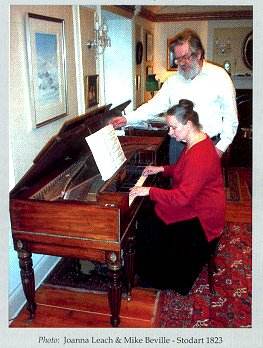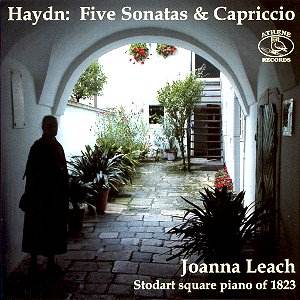Franz Joseph Haydn wrote some 51 sonatas for piano
and several other short piano pieces. Most of these were written in
his early years. He was not a pianist, and, as his career developed,
he lost interest in the genre. Only three of his piano sonatas were
written in the last twenty years of his life.
Haydn is best known for his string quartets and symphonies,
but his piano sonatas, despite many of them following a rigid three-movement
structure, show a great deal of experimentation. (He also wrote nine
sonatas with just two movements, and two sonatas with four movements.)
The vast majority of his sonatas were written in major keys (only seven
are in minor keys), and their melodic development is magnificent. Nevertheless,
not many of them contain virtuoso passages, and some of them sound relatively
simple. This does not detract from their musicality, but it may explain
why Haydn's piano sonatas are not performed very often.
The period instrument movement, after restoring original
(or approximately original) sounds to music of the baroque period and
earlier has been, in recent years, focusing on 18th and 19th century
works. Haydnís piano sonatas sound totally different on a modern piano
than on the type of instrument he actually played. While the square
piano (actually a rectangular instrument, similar in shape to a clavichord,
but larger) used on this recording was built after his death, it is
still much closer to the fortepianos that Haydn would have played.
This kind of instrument produces a totally different
sound, especially a quicker decay and much less resonance. This can
be heard in the second movement, the Largo e sostenuto, of the D major
sonata Hob. XVI/37, where the chords played fade into nothingness, rather
than echoing on a modern piano. The overall impression one gets from
this movement is far different from any recording on a modern piano
- there is a greater feeling of sadness here. Joanna Leach avoids the
trap of increasing the tempo, and performs the silence as well as she
plays the notes.
Leachís performances are very emotional. She puts a
lot of energy into these works, and the joyous movements are brimming
with happiness, while the starker sections are truly dark. There is
a strong contrast between the various movements of some of the sonatas.
The C# minor sonata begins with a powerful, aggressive Moderato, which
Leach plays as if it were a declamation. The middle movement of this
sonata, Scherzando allegro con brio, comes off with the lightest of
touch, sounding like autumn leaves skitting about on a frozen lake.
And the final movement, Minuet & Trio: Moderato, has the introspective
sound of a minor key, the minuet delicate and slow, as if accompanying
dancers in their final dance, as the candles are burning down to their
stumps and night is passing to morning.
One cannot but enjoy this disc, for its multitude of
colours and emotions, for the true joy that Joanna Leach brings to this
great music. She gives more beauty to her interpretations than she does
virtuosity, but, after all, isnít that what this music is all about?
Kirk McElhearn



